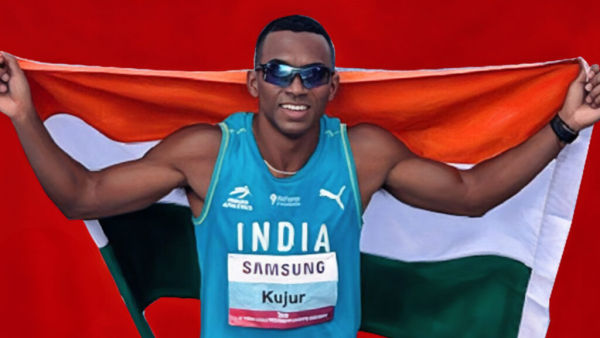
Samira Vishwas
Tezzbuzz|11-07-2025
When 22-year-old Animesh Kujur dashed across the finish line in 10.18 seconds at the recent World Athletics Continental Tour Challenger meet, he did more than just break India’s national record in the 100 metres. He shattered a psychological barrier for Indian sprinting. For decades, the notion that Indian sprinters could not break into the sub-10.2s bracket was taken for granted. But with his explosive stride and fluid power, Kujur dumped that myth and in doing so, became the face of something much larger.
Also read: Indian mixed 4x400m relay team sets national record while winning gold in Asian Relays
Beyond that performance in Geneva, behind the cheers and headlines, lies a story of a deeper, quieter change. A revolution, silent, slow, but stirring, is unfolding on the tracks of Indian athletics.
Surge in performances
Over the past 12 months, Indian athletics has witnessed a surge in performances that suggest a systemic shift. In March-April-May 2025, national records in men’s 100m, 200m, and 4x100m relay were all broken. The men’s relay team clinched gold at the Taiwan Athletics Open 2025 with a time that stunned seasoned observers, while Jyothi Yarraji, one of India’s brightest young stars, continues to push boundaries in the 100m hurdles.
Also read: Durand Cup returns to Manipur with grand trophy tour
A promising long jumper, Shaili Singh, came within striking distance of Anju Bobby George’s longstanding national record (6.83m), a benchmark many believed would stand untouched for a generation. India didn’t just compete in Taiwan but dominated by topping the medal tally with 16 medals, ahead of traditional powerhouses like Australia and South Korea.
These aren’t flashes in the pan. They’re indicators of a base that is strengthening, a system that’s maturing, and a generation of athletes that is finally being given the tools to succeed.
Government’s efforts
What explains this sudden acceleration? The seeds were sown years ago and they’re now starting to bear fruit.
The government’s Khelo India programme, launched in 2016, was among the first large-scale efforts to identify and nurture talent at the grassroots. Alongside it, the Target Olympic Podium Scheme (TOPS) zeroed in on elite athletes with medal potential, offering them structured financial support, foreign exposure, and scientific training environments.
Also read: Pro Kabaddi League (PKL) season 12 from August 29
But experts say what has truly pushed things forward is the confluence of three forces: smarter coaching, private investment, and a generational shift in aspiration.
Private academies
A growing number of Indian athletes are now training under international-standard coaches, both in India and abroad. The days of ‘raw talent’ being enough are over – performance analytics, biomechanics labs, nutrition experts, and physiotherapy teams are integral parts of the package now.
Institutions like JSW Sports, Reliance Foundation, and Olympic Gold Quest (OGQ) have filled the gaps where government efforts fall short. They have set up academies, sponsored international training trips, hired sports scientists, and ensured that athletes are monitored and mentored all through the year. In Bhubaneswar, Thiruvananthapuram, and Patiala, new hubs are emerging, away from the glare of big cities, but humming with Olympic dreams.
Names like Kujur and Yarraji are only the tip of the iceberg. Amlan Borgohain, a sprinter from Assam, continues to impress in the 200m just as Gurindervir Singh shines in the 100m dash. Gurindervir was also the previous holder of the 100 metre record, which was broken in March this year. Long jumper Jeswin Aldrin has already breached the 8.42m mark. These are further proofs that Indian athletics is not limited to a few events; it’s expanding across disciplines.
Mindset is changing
Most of these athletes don’t come from elite urban academies. They come from tier-2 towns and modest backgrounds, are spotted by scouts and polished in national camps or private initiatives. The system, though still far from perfect, is finally catching talent early and giving it room to breathe and grow.
The Paris 2024 Olympics may have passed, but Indian athletics is building with 2028 (Los Angeles) and perhaps even 2036 in mind. India’s bid to host the 2036 Olympics, with Ahmedabad being projected as a potential host city, has added urgency and ambition to the roadmap. A new National Sports Policy was announced recently, outlining a 10-year vision focused on infrastructure, athlete welfare, and incentivising private participation.
Apart from this roadmap, sporting bodies are slowly shifting their focus from short-term medal counts to long-term systems. Junior championships are being monitored with the same seriousness as senior meets. School-level athletic programmes are being revived. State federations, once sluggish, are under greater scrutiny and accountability.
Even the mindset is changing. Most Indian athletes are no longer content with just qualifying for Asian meets, they are talking about Olympic semis, world championship finals, and global podiums. In fact, Kujur himself mentioned his desire to go sub-10 seconds and compete with the Olympic sprinters, a feat that his coach suggests is possible.
Role of 2010 CWG
This remarkable change didn’t begin overnight. This transformation has been in the making for well over at a decade. The 2010 Commonwealth Games in Delhi, despite controversies, was a watershed moment in terms of infrastructure. Neeraj Chopra’s gold in Tokyo 2021 was another inflection point, a javelin thrower from a Haryana village announcing India’s place in a global event where track and field excellence is revered.
Each breakthrough has added fuel to the movement. While it may not grab daily headlines like cricket or even badminton, athletics is slowly but surely laying down foundations that could transform India’s sporting future.
Critics point out, and rightly so, that challenges remain. State-level infrastructure is still patchy. Many coaching centres still function without proper equipment. Recovery and rehab facilities are sparse outside a few elite hubs. Administrative inefficiencies continue to plague smaller federations. And despite private interest, financial security for most athletes remains precarious.
But revolutions are not always loud. Some begin quietly on a dusty track in Bhubaneswar, in a night sprint under floodlights in Geneva, or in a national camp where a 19-year-old breaks the 10.2s barrier.
The change is here. The sprint is on!

Five HCA members arrested for blackmailing SRH owner Kavya Maran

The Bowler Behind Lord's: Who Helped Create Cricket's Mecca

Rohit Sharma Meets 'Baba Nirala' - Photo Breaks The Internet

India Set Unwanted Record As Shubman Gill Loses Toss At Lord's






